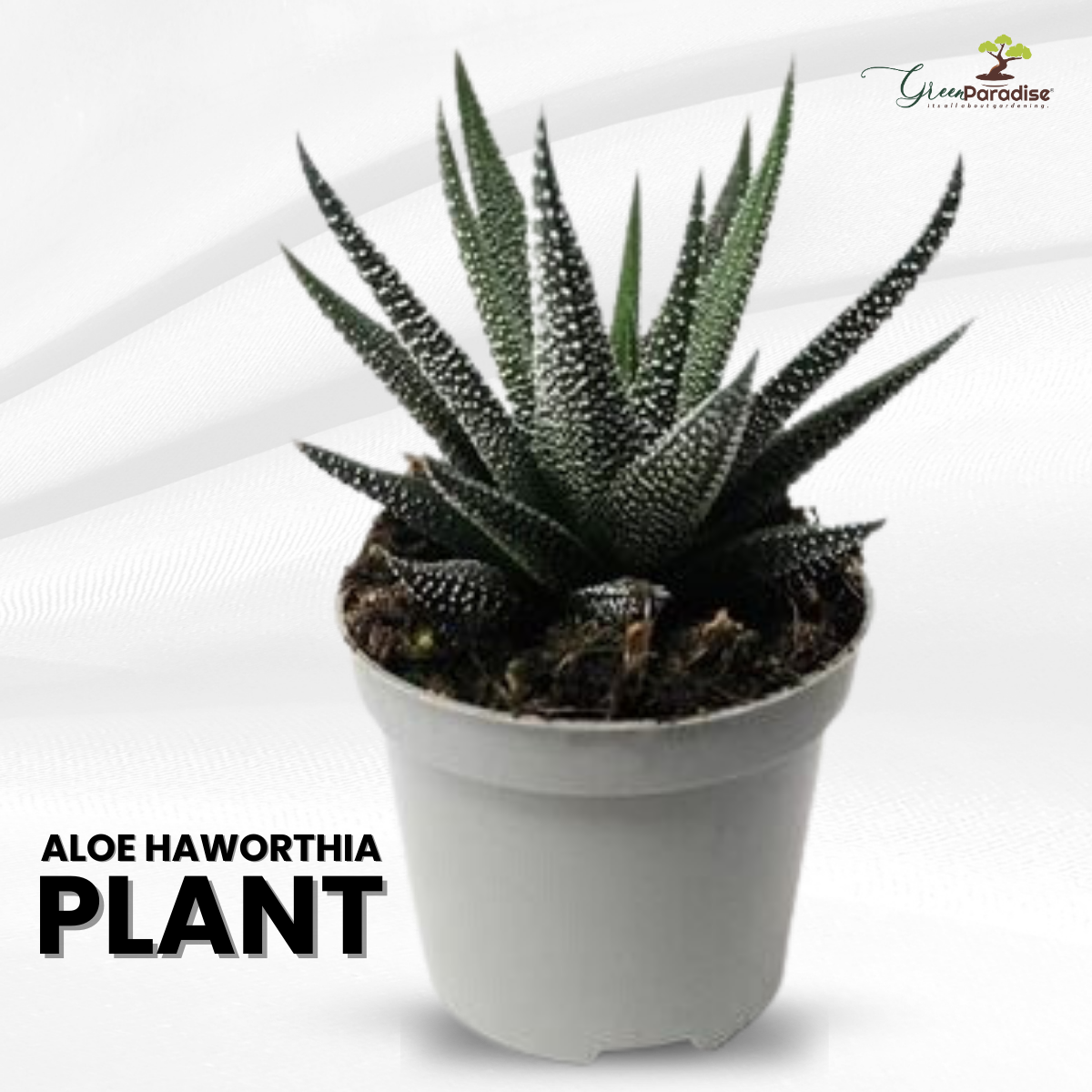



Green Paradise Offers Beautiful Aloe
Haworthioid Plant
About Aloe Haworhioid Plant
Aloe haworthioides is a succulent factory of the Asphodelaceae family. It is commonly known as the Haworthioid Aloe or Haworthia-leaved Aloe. While there isn't a specific plant species called "Aloe haworthioid," it may refer to a hybrid or a variant of the Haworthia genus that closely resembles the Aloe plants in its growth habit and appearance.
Haworthia plants, including Haworthioid Aloe, are native to the Eastern and Southern parts of Africa. They are known for their compact rosette shape and thick, fleshy leaves. These plants are typically small in size, growing up to 4-8 inches (10-20 cm) in height. The leaves are usually triangular or lanceolate, with patterns of stripes, spots, or raised tubercles, depending on the specific variety.
Aloe haworthioides and other Haworthia species are popular houseplants and are commonly cultivated for their attractive appearance and low maintenance requirements. They are well-suited for indoor conditions and can be grown in small containers or succulent gardens. These plants prefer bright but indirect sunlight and require well-draining soil to prevent root rot.
Like other succulents, Aloe haworthioid plants have adapted to survive in arid environments and have the ability to store water in their leaves. As a result, they have low water requirements and should be watered sparingly, allowing the soil to dry out between waterings. Overwatering can lead to root rot and other issues, so it's important to avoid excessive moisture.
In terms of care, Aloe haworthioid plants thrive in temperatures ranging from 65-80°F (18-27°C). They prefer a slightly cooler temperature during the winter months to mimic their natural dormancy period. Fertilizing is not required frequently, but a balanced, diluted succulent fertilizer can be applied during the growing season to promote healthy growth.
Propagation of Aloe haworthioid plants can be done through offsets or leaf cuttings. equipoises are small shops that grow from the base of the parent factory and can be separated and seeded. Leaf cuttings involve carefully removing a healthy leaf and allowing it to callus for a few days before placing it in well-draining soil to root.
Overall, Aloe haworthioid or Haworthioid Aloe is a beautiful succulent plant that can be a great addition to your indoor plant collection. Its unique appearance, low maintenance requirements, and ability to tolerate indoor conditions make it a popular choice among succulent enthusiasts.
How To Grow Aloe Haworthioid Plant
To grow an Aloe Haworthioid plant, also known as Haworthia, you can follow these steps:
Select a suitable pot:
-
Choose a well-draining pot with drainage holes at the bottom.
-
A clay or terracotta pot is a good choice as it allows excess water to evaporate.
Potting mix:
-
Use a well-draining succulent or cactus potting mix.
-
You can also produce your own blend by combining regular replanting soil with beach or perlite to ameliorate drainage.
Planting:
-
Fill the pot about two-thirds full with the potting mix.
-
Gently remove the Haworthia plant from its nursery pot and place it in the center of the new pot.
-
Make sure the roots are not crowded and are spread out.
Light requirements:
-
Haworthias prefer bright, indirect sunlight.
-
Place the pot near a window where the plant receives several hours of bright, filtered sunlight each day.
-
Avoid exposing the plant to intense, direct sunlight as it can scorch the leaves.
Watering:
-
Between waterings, allow the soil to dry out. Haworthias are succulent plants and can withstand periods of drought.
-
Water the plant thoroughly, ensuring that water reaches the roots, but avoid overwatering as it can lead to root rot.
-
Discard any redundant water that collects in the goblet beneath the pot.
Temperature and humidity:
-
Haworthias thrive in average room temperatures between 65-80°F (18-27°C).
-
They prefer moderate humidity but can adapt to drier conditions found indoors.
Fertilization:
-
Haworthias are not heavy feeders.
-
You can use a balanced, diluted fertilizer specifically formulated for succulents or cacti.
-
Apply the fertilizer sparingly during the growing season (spring and summer) according to the instructions on the package.
Propagation:
-
Haworthias can be propagated through offsets, which are smaller plants that grow from the base of the mother plant.
-
Carefully separate the offsets when they are large enough and plant them in their own pots using a similar potting mix.
Maintenance:
-
Remove any dried or withered leaves to maintain the plant's appearance.
-
If the plant becomes leggy or elongated, it may benefit from more sunlight.
-
You can also rotate the pot periodically to ensure even growth.
Pests and diseases:
-
Haworthias are generally resistant to pests and diseases.
-
However, overwatering can lead to root rot or fungal issues.
-
If you notice signs of pests, such as mealybugs or scale insects, gently wipe the leaves with a cotton swab dipped in rubbing alcohol.
With proper care and attention, your Aloe Haworthioid plant should grow and thrive. Remember to adjust the care routine based on the specific conditions of your environment and the needs of your plant.




